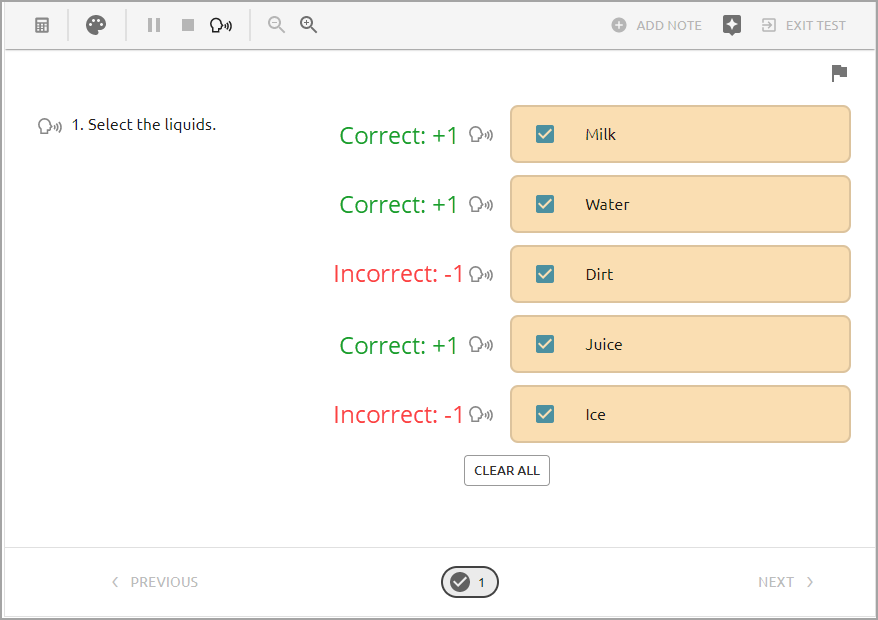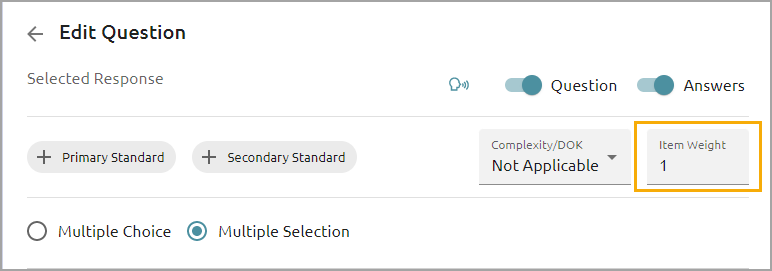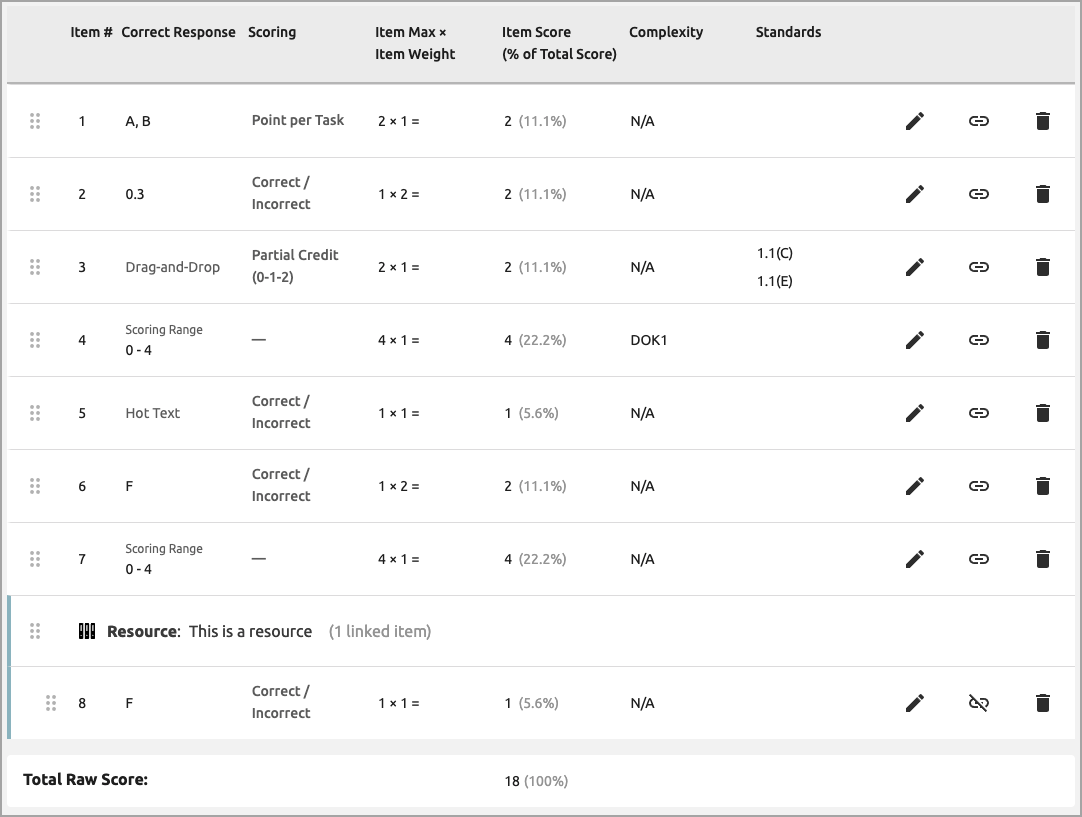For most item types, Aware offers three main types of scoring methods: Correct/Incorrect, Point per Task, and Partial Credit (0-1-2), the latter two of which also apply penalty scoring.
Only Multipart items can utilize Dependency scoring, which won’t be covered here.
To change the default setting of Correct/Incorrect, select the Scoring Method from the drop-down menu on the item.

The scoring rules available for each question are detailed in the chart below.
Point per Task | Partial Credit | Correct / Incorrect | |
|---|---|---|---|
Multiple Choice | ✓ | ||
Numerical Response | ✓ | ||
Match Table Grid | ✓ | ✓ | ✓ |
Hot Spot | ✓* | ✓* | ✓ |
Drag-and-Drop | ✓ | ✓ | ✓ |
Multiple Selection | ✓ | ✓* | ✓ |
Text Entry | ✓ | ✓ | ✓ |
Equation Editor | ✓ | ✓ | ✓ |
Inline Choice | ✓ | ✓ | ✓ |
Hot Text | ✓* | ✓* | ✓ |
Number Line | ✓ | ✓ | ✓ |
Charting | ✓ | ✓ | ✓ |
Basic Graphing | ✓ | ✓ | ✓ |
Intermediate Graphing | ✓ | ||
Inequality Graphing | ✓ | ✓ | |
Fraction Model | ✓ |
* Penalty scoring enabled
Note: Constructed Response items use a teacher-defined scoring range.
What Is Penalty Scoring?
Penalty scoring applies when a student selects incorrect answer choices alongside correct answers, preventing them from gaining points through blind guessing.
Hot Spot, Multiple Selection, and Hot Text items automatically enable penalty scoring when test authors assign Partial Credit or Point per Task scoring to an item.
An item assigned the Point per Task scoring method may have 3 correct answer choices and 2 incorrect choices. If a student selects all answer choices, they will receive a scoring penalty and only 1 point for the item. In other words, 3 points + (-2 points) = 1 point.
In the same scenario for an item assigned the Partial Credit scoring method, the student selects all 5 answer choices and receives a scoring penalty: 3 points + (-2 points) = 1 point. Since the student did not get half or more answers correct due to the penalty score, they cannot receive the 1 point of partial credit.
Penalty scoring will never result in giving a student a negative score.
Correct/Incorrect Scoring
Correct/Incorrect scoring defaults as the scoring option for all item types except Constructed Response. Students receive one point or zero points for Correct/Incorrect questions. Scoring can be weighted.
Partial Credit Scoring
Partial Credit scoring is available to all question types except Multiple Choice, Numerical Response, Intermediate Graphing, and Constructed Response. Items set to partial scoring display at 0/2, 1/2, and 2/2. If the item is set to score with a penalty, an asterisk (*) displays next to the score.
Note: With Partial Credit scoring, the maximum number of points students may earn per question is two, regardless of how many responses are incorporated into a question.
Students must select at least half of the correct responses to receive partial credit of one point. Students whose correct responses are less than half of the available correct responses receive zero points. Students must continue to select all available correct responses to receive two points.
Eduphoria’s Partial Credit scoring item types continue to align with all TEA scoring practices. If students correctly identify all of the item responses, they receive a maximum score of two (2) points no matter how many correct responses are required. For example, if an assessment question has five correct response interactions and students select all five, they will receive a maximum of two points.
Current Partial Credit Scoring ( 3 correct responses ) | |
|---|---|
Correct Responses | Credit Points |
0-1 | 0 points |
2 | 1 points |
3 | 2 points |
For Partial Credit scoring questions, students who select half or more of the correct responses receive one (1) point. For example, students who choose three or four correct answers for an assessment question with five correct responses receive a maximum of one point.
Current Partial Credit Scoring ( 4 correct responses ) | |
|---|---|
Correct Responses | Credit Points |
0-1 | 0 points |
2-3 | 1 points |
4 | 2 points |
Students who select less than half of the correct responses receive zero (0) points. For example, for an assessment question with five correct answers, students receive no credit even if they select one or two correct responses.
Current Partial Credit Scoring ( 5 correct responses ) | |
|---|---|
Correct Responses | Credit Points |
0-2 | 0 points |
3-4 | 1 points |
5 | 2 points |
Point per Task Scoring
Using Point per Task scoring, students receive one point for each correct entry on a test. For example, if a Text Entry question has three correct answers, students receive one point for each entry that is correctly answered. In another example, on a Drag-and-Drop question with six potential correct answer choices, students who correctly select three out of the six answer choices are awarded three points.
Items set to score with a penalty will have an asterisk (*) display next to the score.
Point per Task scoring functions differently for Hot Text, Hot Spot, and Multiple Selection questions. For example, on a Multiple Selection question with five answer choices, three are correct and two incorrect. Depending on student selections, different scenarios are possible.
Scenario 1: Only Correct Answer Choices Selected – If students select the three correct answers, they receive three points.
Scenario 2: Some Correct Answers Choices Selected – If students identify two out of the three correct answers, they will receive two points.
Scenario 3: All Answer Choices Selected – If students select all five answer choices, the three correct and the two incorrect, they receive only one point. Students who select all available answer choices are penalized two points since they selected two incorrect answer choices in addition to the three correct answer choices.
Note: If the directions indicate the student should select three correct answers, the testing system does not limit students to selecting only three answer choices. Students will be able to select every answer.

Item Weight
The above examples assume an item weight of one. If the item has a weight of two, the values double. With an item weight of three, the values triple. Item weight can be adjusted in the Test Key view or when editing the question.

Test Key Tab
The Test Key tab allows the test author to:
update the correct response,
add the complexity level (DOK),
update scoring methods and item weight,
view the total raw score/percentage,
add learning standards,
and view the question type.

Data Analysis
Including multiple scoring methods for an assessment impacts data analysis. When Partial Credit or Point per Task is included in an assessment, students have the ability to earn more points per question. Partial credit appears in the form of additional raw score points for the assessment. Selecting Partial Credit directly impacts the percentage score for learning standards, reporting categories, etc.
If standards are tested in more than one question per assessment, different scoring scenarios are possible. Partial Credit scoring changes the percentage scores under each standard.
Scenario 1: One question assesses standard 3.5(C). The question uses Partial Credit scoring with five interactions at a weight of one. If a student correctly identifies three of the five answer choices, the percentage for that question will be 60%. If a student correctly identifies four out of five answer choices, the percentage is 80%.
Scenario 2: Two questions assess standard 3.5(C). Both questions use Partial Credit scoring with four interactions at a weight of two. The scoring for each question is a raw score of four, equalling a total raw score of eight for both questions. If a student correctly identifies four of the answer choices for both questions, the total raw score is four and the percentage is 50%.
Scenario 3: Two questions assess standard 3.5(C). The first question uses Correct/Incorrect scoring set at a weight of one, and the second question uses Partial Credit scoring with five interactions set at a weight of one. If a student correctly identifies the answer for the Correct/Incorrect question, but only correctly identifies three out of the five answer choices for the Partial Credit question, then the overall percentage for standard 3.5(C) would be 66.67%, rounding up to 67%.
Additional Information
For additional information about scoring methods, visit the resources below:
Interactive item types appear on the Incorrect Response Report.
Data analysis and detailed information is available for each of the interactive item types.
Multiple Selection data analysis shows student selections in detail.